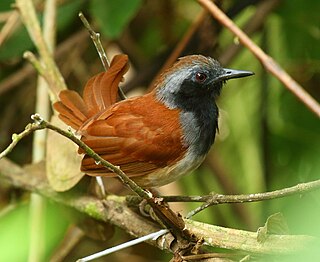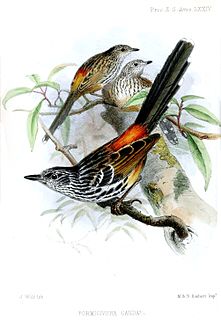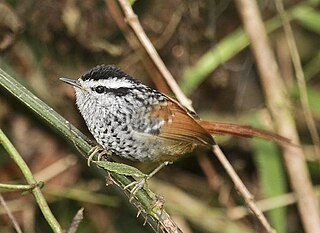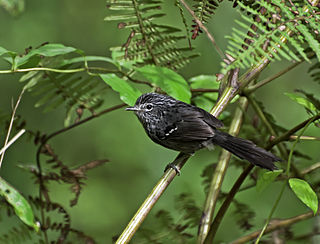The Sibley-Monroe checklist was a landmark document in the study of birds. It drew on extensive DNA-DNA hybridisation studies to reassess the relationships between modern birds.

The white-bellied antbird, is a passerine bird which breeds in the tropical New World from Panama to northern Brazil and in Trinidad. It is also called Swainson's antcatcher after William John Swainson, who first described it scientifically. The genus is monotypic.

The East Andean antbird is a species of bird in the family Thamnophilidae. It is found at high levels in humid highland forests, especially near bamboo, and is endemic to the western slope of the Eastern Andes and the Upper Magdalena Valley in Caquetá and Huila in Colombia. This 15 cm (5.9 in) bird is found at high elevations of about 1,500-2,500 m. It was formerly considered conspecific with the Klages's antbird, the Santa Marta antbird, and the streak-headed antbird and together called the long-tailed antbird.

Drymophila is a bird genus in the antbird family (Thamnophilidae). It is a relative of the typical antwrens.
The striated antbird is a species of bird in the family Thamnophilidae, the antbirds. It is found in the western and south-central Amazon in South America. As presently defined, it has two subspecies: the nominate subspecies in the west, and D. d. subochracea in the south-central Amazon. The latter is sometimes known as the Xingu antbird, but this leads to confusion with Willisornis vidua.

The ferruginous antbird is an insectivorous bird in the antbird family Thamnophilidae. It is endemic to Atlantic Forest in south-eastern Brazil. It was formerly considered conspecific with the very similar Bertoni's antbird.

The rufous-tailed antbird is a species of bird in the family Thamnophilidae.

The dusky-tailed antbird is an insectivorous bird in the antbird family Thamnophilidae. It is found in southeast Brazil, southern Paraguay, and northeast Argentina . Its natural habitat is subtropical or tropical moist lowland forest.

The ochre-rumped antbird is a species of bird in the antbird family Thamnophilidae. It is endemic to Brazil, in the east and south east of the country in the Atlantic Forest Mountains EBA. It has fairly specific habita requirements, mostly being found in dense bamboo thickets and the thick understory of montane forest, and also more rarely in lowland evergreen forest, from 300 to 1,950 m (980–6,400 ft).

Bertoni's antbird is a species of bird in the family Thamnophilidae. It is found in the Atlantic Forest of south-eastern Brazil, eastern Paraguay and far north-eastern Argentina (Misiones). It was formerly considered conspecific with the very similar ferruginous antbird.

The scaled antbird is a species of bird in the family Thamnophilidae. It is endemic to Brazil.

Formicivora is a genus of insectivorous birds in the antbird family, Thamnophilidae. These relatively small, long-tailed antbirds are strongly sexually dichromatic. They are found in semi-open habitats in woodland and shrub in South America. They have several rows of white spots on the wings. Males are usually darker below than they are above, and sometimes have a fringe of white on the side.
The fringe-backed fire-eye, also known as Swainson's fire-eye, is a rare species of bird in the antbird family that is endemic to Brazil. Names in other languages include Olho-de-fogo-rendado and papa-taoca-da-bahia in Portuguese, Batará de Swainson and Ojodefuego de Bahía in Spanish, Alapi noir and Priglène à manteau tacheté in French, and Fleckenmantel-Feuerauge and Fleckenmantel-Feueraugef in German.

The fire-eyes, Pyriglena, are a genus of birds in the antbird family Thamnophilidae.The genus contains three species, all found in South America. The fire-eyes are 16–18 cm in length, weigh 25-36 g and have characteristic red eyes that give them their name. They have sexually dimorphic plumage, with the females possessing brown to buff coloured bodies with black tails, and the males being black with small patches of white on the back or wings. The fire-eyes eat a variety of insects, and will regularly follow army ants in order to catch prey flushed by them. Two of the fire-eyes are widespread and safe, but one species, the fringe-backed fire-eye, is threatened with extinction.
D. ferruginea may refer to:
Émile Deville was a French physician, naturalist and taxidermist.

The streak-headed antbird is a species of bird in the family Thamnophilidae. It is found in humid highland forests, especially near bamboo, ranging through the Andes from Bolivia to Colombia. This 15 cm (6 in) bird is found at higher elevations. It was previously considered conspecific with the long-tailed antbird.

The Klages's antbird is a species of bird in the family Thamnophilidae. It is found in humid foothill forests, from Venezuela to NE Colombia in Serranía de Perijá and the northern Eastern Andes, especially in association with bamboo. This 15 cm (6 in) bird is found at higher elevations. It was previously considered conspecific with the long-tailed antbird.
The Santa Marta antbird is a species of bird in the family Thamnophilidae. It is endemic to humid foothill forests of the Sierra Nevada de Santa Marta in Colombia, especially in association with bamboo. This 15 cm (6 in) bird is found at higher elevations. It was previously considered conspecific with the long-tailed antbird.












